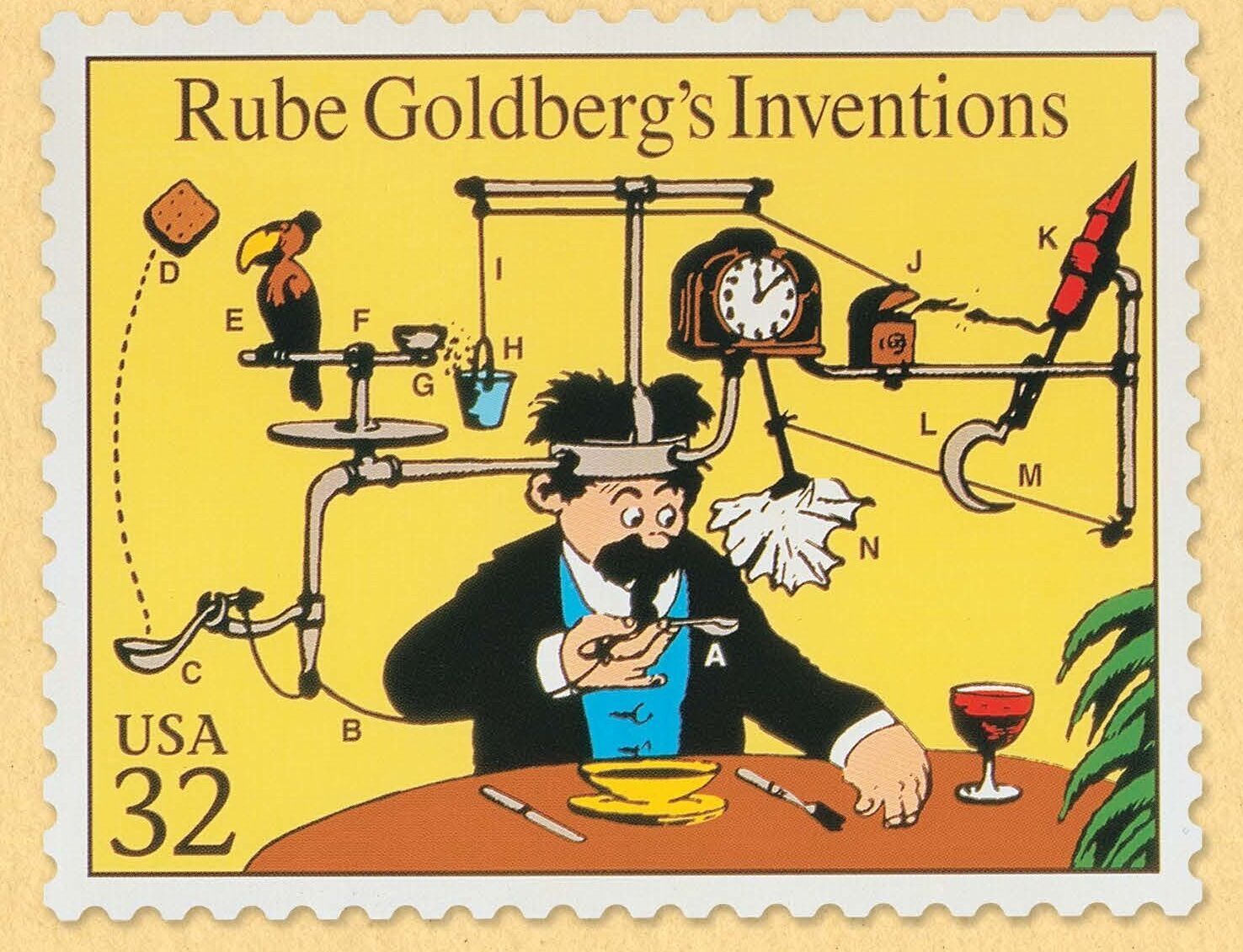This Thanksgiving season, there are several opportunities to experience the legendary Rube Goldberg. The Rube Goldberg Cartoon Gallery features the cartoon “simple way to carve a turkey,” as well as many other classic whimsical inventions “for fun, laughs and inspiration!” Flip through the Merriam-Webster dictionary and discover an entry which defines “Rube Goldberg” as “accomplishing by complex means what seemingly could be done simply.”
So how do you “simply” carve a Thanksgiving turkey, Rube-Goldberg style?

To see, experience and even touch life-size Rube Goldberg contraptions in person, head to Philadelphia this Thanksgiving, Chanukah or winter break for “The Art of Rube Goldberg”—the first retrospective exhibit in 40 years—on display at the National Museum of American Jewish History from Oct. 12 to Jan. 21.
Visitors will learn that Goldberg was a man of many talents and interests, which over the course of his 72-year career extended beyond whimsical invention cartoons to include sports writing; answers to stupid questions in his “Foolish Questions” series (first published in the New York Evening Mail in 1908); political cartooning; his satirical takes on fashion, sports, politics, gender roles and other aspects of modern life; and his work as an early ad man.
Museum guests will also see why Goldberg has been an inspiration for generations of aspiring scientists, engineers and inventors of all ages. In many ways, he could be considered the granddaddy of STEAM—the popular, school-based approach to learning using Science, Technology, Engineering, the Arts and Mathematics as entry points for student questioning, critical thinking and discussion.
Adopting a comic style (and some funny friends)
Goldberg was born Rueben Garret Lucius Goldberg in San Francisco on July 4, 1883, the second of four children to German-Jewish immigrant parents Max Goldberg and Hannah Cohen. Though he wanted to be an illustrator from an early age, his parents had other ideas. Rube’s father was a police and fire commissioner who was also involved in real estate, banking and politics. He pushed Goldberg to attend the University of California-Berkeley, where he studied mining and engineering, and wrote for the college humor paper.
He did not push as hard a few years earlier when it came to celebrating bar mitzvah. According to Dr. Josh Perelman, chief curator and director of exhibitions and interpretation, Rube’s parents were traditional Jews, but “Rube diverged with his father around identity. He refused to become bar mitzvah. He is not what we would call a practicing Jew.” Yet, Perelman points out that “there is a sense of Jewishness in his work.”
Perelman, who spoke with JNS at the Rube Goldberg exhibit, describes Goldberg as “a very observational cartoonist—he was a member of a minority community, he was on the outside looking in. He walked the line between feeling he was a minority and feeling he was an integrated member of society. And there was a social-awareness theme with political overtones throughout.”
Goldberg’s first and last job directly related to his undergraduate engineering training was with the San Francisco sewer company. Needless to say, he wasn’t happy there and was willing to take a big pay cut to become a sports cartoonist for the San Francisco Chronicle. The exhibition traces Goldberg’s extensive and eclectic career, including his innovative early work with original drawings that reveal the beginnings of his comic style, then follows his steady rise to fame as a nationally syndicated presence in the 1920s and 1930s. Highlights include one of his earliest drawings, “The Old Violinist” from 1895, an original concept drawing of Boob McNutt and Bertha from the 1920s, and original artwork for such comic-strip series’ as Foolish Questions, Mike and Ike-They Look Alike and Boob McNutt (from the 1910s and 20s).
Goldberg was both influenced by and a participant in early film. He wrote the script for the 1930 Three Stooges movie, “Soup to Nuts,” designed many of the set pieces (chairs, tables) and even made a cameo appearance. His friends included the Three Stooges, Charlie Chaplin and Groucho Marks. His classic self-operating napkin sequence appears in Charlie Chaplin’s “Modern Times” (1936). The exhibit also features a rare interview of Goldberg by legendary broadcaster Edward R. Murrow.
‘Reintroduce him to the world’
Also on display are examples of children’s toys, hobby kits and board games inspired by Goldberg’s invention drawings. Goldberg had two U.S. patents, given in 1936, for the comic strip “LalaPalooza.” As the exhibit notes, his cartoons “shifted focus with political discord mounting in Europe.” Further, “he never shied away from hot-button social and political issues, and temperance and prohibition were recurring themes.”
Goldberg also offered early commentary on the Israel-Arab situation. In 1947, he sketched a black-and-white cartoon of two people walking in the desert on what seems to be parallel paths. One is identified as “Jews” and the other “Arabs.” The caption reads: “When will they find a meeting point?” Goldberg received the Pulitzer Prize for Editorial Cartooning in 1948. Later, he drew an editorial cartoon right after World War II that focused on the threat of nuclear war.
The exhibition ends with a survey of Goldberg’s work during his final decades and with a look at his lasting influence on popular culture. For example, Goldberg appears in advertisements for various cigarette, motor oil, gin, car and tire companies. His granddaughter, Jennifer George, reports, “The more I got to know him through his work, the more I understood how important it was not just to keep his legacy going, but to reintroduce him to the world.”
She and the exhibit have done a very commendable job. While Goldberg died in 1970, the official Rube Goldberg website notes that “Rube Goldberg lives on in pop culture, and is referenced daily in both print and digital media. His name is searchable, hash-taggable, and at best, viral.”
Fans and aspiring inventors can celebrate Rube Goldberg’s legacy by creating Rube Goldberg Machines™ in an annual Rube Goldberg Machine Contest.


























